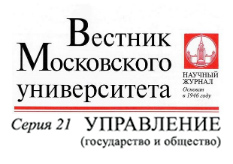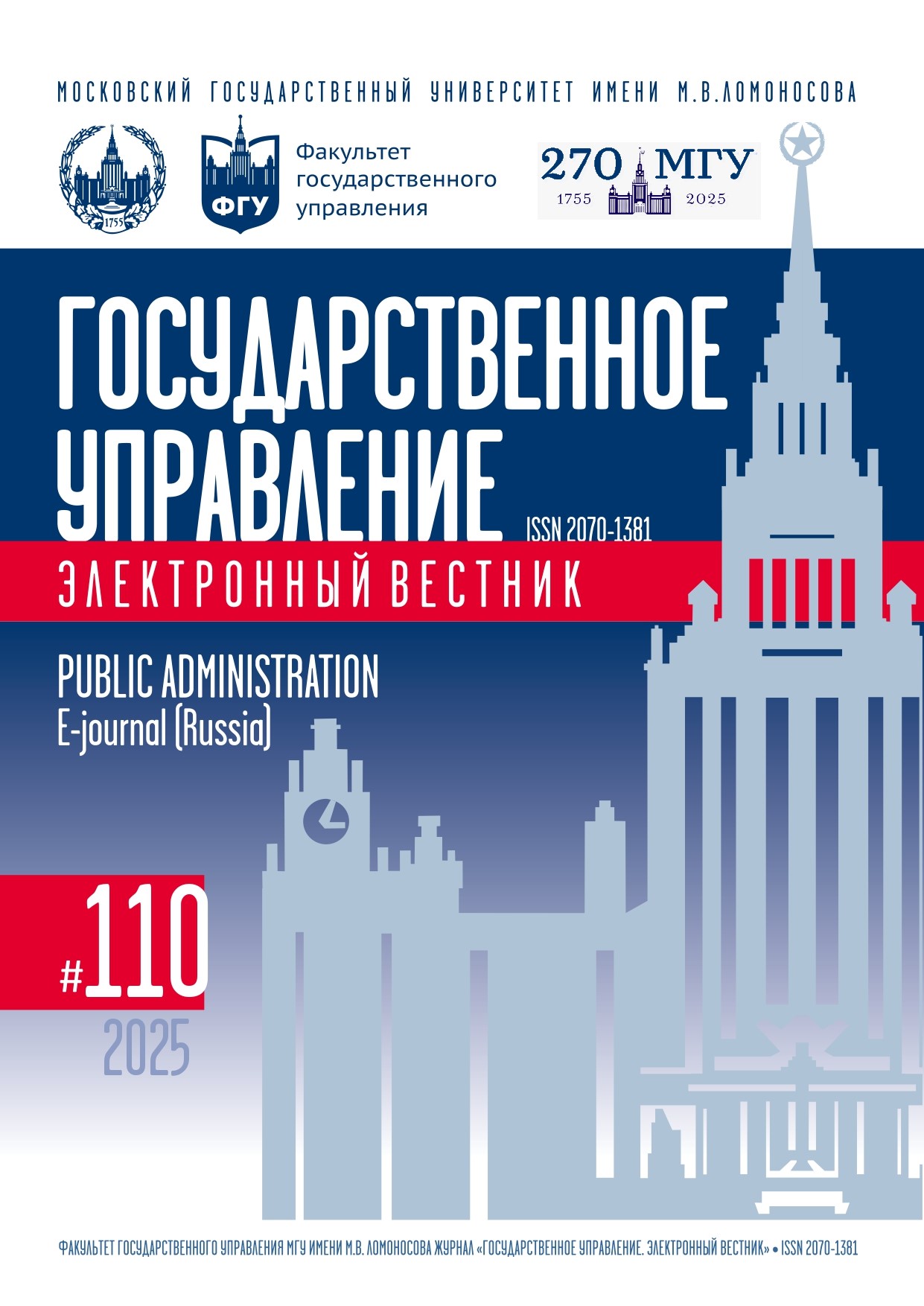Fostering Social Innovations in the Nonprofit Sector in an Uncertain Environment
DOI:
https://doi.org/10.55959/MSU2070-1381-110-2025-101-114Keywords:
Social innovation, Lean Impact, organizational ambidexterity, basic and incremental innovation, exploration and exploitation, nonprofit management.Abstract
One of the uncertainty management tools used by nonprofit organizations (NPO) is the development of social innovations, allowing the organization to take a proactive position in relation to changes occurring in society. However, in practice, not all nonprofit organizations manage to effectively engage in innovative activities within the framework of implementing their main social mission. The aim of this article is to identify the features of creating social innovations in conditions of a high degree of uncertainty of the external environment. The Lean Impact and organizational ambidexterity discussed in the article have sufficient potential to ensure the innovation process in NPOs. Following the basic principles of Lean Impact (think bigger, start small and relentlessly seek impact), as well as the practical implementation of the “build — measure — learn feedback” loop contribute to increasing the efficiency of NPO innovation activities, shortening the innovation cycle and reducing the likelihood of failure. The concept of organizational ambidexterity focuses on finding a balance between basic and incremental innovations in NPOs in the context of achieving a three-pronged goal: implementing a social mission, adapting to the needs of beneficiaries and donor requirements, and maintaining financial sustainability. The main stages of implementing organizational ambidexterity in a nonprofit organization are: initial restructuring, collaborative ecosystem work, and launching a joint project by partner organizations. The key to successfully finding a balance between basic and incremental innovations in NPOs is the organic combination of three types of ambidexterity: structural (creating appropriate units responsible for experimenting with MVPs, implementing programs, and scaling them), contextual (strategic hiring and coordinated management efforts), and interorganizational (collaborating with partner organizations to create innovative solutions). The use of Lean Impact and organizational ambidexterity in the nonprofit sector will help improve internal organizational dynamics, maintain social effectiveness, and strengthen financial sustainability.
References
Веретенникова А.Ю., Омонов Ж.К. Разработка и внедрение социальных инноваций в гражданском обществе // Журнал экономической теории. 2018. Т. 15. № 1. С. 84–95.
Воронов А.С., Исаева А.Э. Бизнес-экосистема и ее влияние на государственное управление предпринимательской деятельностью: теоретический обзор предметной области // Государственное управление. Электронный вестник. 2023. № 97. С. 138–154. DOI: 10.24412/2070-1381-2023-97-138-154
Дженас К.К. Успех социального стартапа. Как запускаются, растут и меняют мир лучшие некоммерческие проекты. М.: АНО Портал «Такие дела», 2019.
Зуб А.Т. Эквифинальность в организационном проектировании // Актуальные вопросы экономических наук. 2011. № 19. С. 10–19.
Краснопольская И., Скокова Ю. Цифровизация и ИИ в работе НКО: новые тренды и перспективы. М.: «ДПК Пресс», 2024.
Купряшин Г.Л. Политико-административные способности государственного управления в условиях турбулентности и неопределенности // Государственное управление. Электронный вестник. 2023. № 97. С. 174–189. DOI: 10.24412/2070-1381-2023-97-174-189
Лившин А.Я. Некоммерческие организации в системе межнациональных отношений: история и современность // Вестник Московского университета. Серия 21. Управление (государство и общество). 2023. Т. 20. № 4. С. 119–139. DOI: 10.55959/MSU2073-2643-21-2023-4-119-139
Миннигалеева Г.А. Инновационность российских НКО: масштабы и взаимосвязь с особенностями управления // Мониторинг общественного мнения: Экономические и социальные перемены. 2016. № 4. С. 67–78. DOI: 10.14515/monitoring.2016.4.05
Попов Е.В., Омонов Ж.К., Наумов И.В., Веретенникова А.Ю. Тенденции развития социальных инноваций // Terra Economicus. 2018. Т. 16. № 3. С. 36–59. DOI: 10.23683/2073-6606-2018-16-3-35-59
Сидорова А.А. Организационная амбидекстрия: концептуальные основы и современные подходы // Государственное управление. Электронный вестник. 2023. № 98. С. 86–95. DOI: 10.24412/2070-1381-2023-98-86-95
Чанг Э.М. Lean Impact. Инновации для масштабных социальных перемен. М.: АНО Портал «Такие дела», 2020.
Abbas J., Bresciani S., Subhani G., De Bernardi P. Nexus of Ambidexterity and Frugal Innovation for Enhanced ESG Performance of Entrepreneurial Firms. The Role of Organizational Capabilities // International Entrepreneurship and Management Journal. 2024. Vol. 21. DOI: 10.1007/s11365-024-01062-5
Bettin C., Ziyun F., Eriksson P. Open Social Innovation // Elgar Encyclopedia of Innovation Management / edited by P. Eriksson, T. Montonen, P-M. Laine, A. Hannula. Cheltenham: Edward Elgar Publishing Ltd., 2025. P. 113–116. DOI: 10.4337/9781035306459.00038
Cannaerts N., Steijn B., Duijn M. Public Managers, Drivers of Ambidexterity in Public Service Delivery. The Perceived Impact of Red Tape and PSM on Ambidexterity // International Journal of Public Sector Management. 2025. Vol. ahead-of-print. DOI: 10.1108/IJPSM-04-2024-0120
Chesbrough H.W. Open Innovation: The New Imperative for Creating and Profiting from Technology. Cambridge, MA: Harvard Business School Publishing, 2003.
Chijere Z. An Overview on Social Enterprises and Nonprofit Organizations // Nonprofit Social Enterprises. Lessons from Africa. Cham: Springer, 2024. P. 1–7. DOI: 10.1007/978-3-031-60234-4_1
Dansero E., Battisti L., Cuomo F., Pettenati G., Sanesi G., Spano G. Benefits from social innovation // Nature-Based Solutions for Urban Renewal in Post-Industrial Cities / edited by S. Barbero, A. Timpe. New York: Routledge, 2025. Р. 189–206. DOI: 10.4324/9781003474869-12
Dover G., Lawrence T.B. The Role of Power in Nonprofit Innovation // Nonprofit and Voluntary Sector Quarterly. 2011. Vol. 41. Is. 6. P. 991–1013. DOI: 10.1177/0899764011423304
Frumkin P. On Being Nonprofit: A Conceptual and Policy Primer. Cambridge (Mass.), London: Harvard University Press, 2002.
Hamblin R., Plimmer G., Badar K., Lasthuizen K. Organizational Ambidexterity: A Bibliometric Review and Framework for Future Public Administration Research // Public Performance & Management Review. 2024. Vol. 47. P. 1073–1109. DOI: 10.1080/15309576.2024.2373178
Khan A., Chen L.-R., Hung C.-Y. The Role of Corporate Social Responsibility in Supporting Second-Order Social Capital and Sustainable Innovation Ambidexterity // Sustainability. 2021. Vol. 13. Is. 13. DOI: 10.3390/su13136994
Kumalaningrum M.P., Wibowo B.S. Innovation Culture and Ambidexterity: Strategies to Deal with Environmental Uncertainty // COSTING: Journal of Economic, Business and Accounting, 2024. Vol. 6. Is. 7. P. 2176–2187.
March J.G. Exploration and Exploitation in Organizational Learning // Organization Science. 1991. Vol. 2. Is. 1. Р. 71–87.
Murray R., Caulier Grice J., Mulgan G. The Open Book of Social Innovation. London: National Endowment for Science, Technology and the Arts; Young Foundation, 2010.
O’Reilly C.A., Tushman M. Organizational Ambidexterity: Past, Present, and Future // Academy of Management Perspectives. 2013. Vol. 27. Is. 4. Р. 324–338. DOI: 10.5465/amp.2013.0025
Phills J.A., Deiglmeier K., Miller D.T. Rediscovering Social Innovation // Stanford Social Innovation Review. 2008. P. 34–43.
Rhodes M.L., McQuaid S., Donnelly Cox G. Social Innovation and Temporary Innovations Systems (TIS): Insights from Nature based Solutions in Europe // Social Enterprise Journal. 2021. Vol. 18. Is. 2. P. 252–270. DOI: 10.1108/SEJ 01 2021 0001
Seo D., Bryson J.M., Williams M. Nonprofit Sector Ambidexterity: A Framework for Understanding Innovation and Strategy Change in Nonprofit Organizations // Public Management Review. 2025. DOI: 10.1080/14719037.2025.2452880
Shafique I., Kalyar M.N., Shafique M., Kianto A., Beh L.-S. Demystifying the Link between Knowledge Management Capability and Innovation Ambidexterity: Organizational Structure as a Moderator // Business Process Management Journal. 2022. Vol. 28. Is. 5/6. P. 1343–1363. DOI: 10.1108/BPMJ-11-2021-0713
Shahriman M.F., Omar R. The Triadic Edge: Balancing Innovation, Risk, and Organizational Ambidexterity // Advances in Nonlinear Variational Inequalities. 2025. Vol. 28. Is. 5s. P. 79–93. DOI: 10.52783/anvi.v28.3652
Shier M.L., Turpin A., Graham J.R. Partnership Dynamics That Support Social Innovation by Nonprofits // International Journal of Voluntary and Nonprofit Organizations. 2024. Vol. 35. P. 491–502. DOI: 10.1007/s11266-023-00612-9
Soares J.L., Arantes A. Mediating Effect of Management Control Systems in the Interaction between Ambidexterity and Organizational Learning in Brazilian NPO // Journal of Technology Management & Innovation. 2021. Vol. 16. Is. 2. P. 56–69. DOI: 10.4067/S0718-27242021000200056
The International Handbook on Social Innovation. Collective Action, Social Learning and Transdisciplinary Research / edited by F. Moulaert, D. MacCallum, A. Mehmood, A. Hamdouch. Cheltenham / Northhampton: Edward Elgar Publishing Ltd., 2013.
Úbeda-García M., Claver-Cortés E., Marco-Lajara B., Zaragoza-Sáez P. Toward a Dynamic Construction of Organizational Ambidexterity: Exploring the Synergies between Structural Differentiation, Organizational Context, and Interorganizational Relations // Journal of Business Research. 2020. Vol. 112. Р. 363–372. DOI: 10.1016/j.jbusres.2019.10.051
Downloads
Published
Similar Articles
- Aleksandra A. Sidorova, Организационная амбидекстрия: концептуальные основы и современные подходы , Public Administration. E-journal (Russia): No. 98 (2023)
- Aleksandra A. Sidorova, University as an Ambidextrous Organization , Public Administration. E-journal (Russia): No. 108 (2025)
- Elmira Sh. Shaimieva, Guzel I. Gumerova, Elvina R. Gareeva, A Lean Startup to Increase the Competitiveness of Russian Universities: Organizational and Managerial Aspects of Applied Results , Public Administration. E-journal (Russia): No. 111 (2025)
- Alexander A. Kovalenko, Developing the Model of Social Controlling of Enterprise’s Innovative Activity , Public Administration. E-journal (Russia): No. 111 (2025)
- Anna М. Ryabinina, Technologies of Higher Education Internationalization in Modern Conditions , Public Administration. E-journal (Russia): No. 94 (2022)
- Guzel I. Gumerova, S. Hüsig, G. Schewe , Aleksandra J. Butneva, Elmira Sh. Shaimieva, Formation of Organizational and Managerial Approach Based on Management of Intellectual Property Objects in the Field of International Scientific Cooperation , Public Administration. E-journal (Russia): No. 91 (2022)
- Elmira Sh. Shaimieva, Guzel I. Gumerova, Aleksandra J. Butneva, S. Hüsig, G. Schewe, Intellectual Property as a Driver for International Scientific Cooperation: Development of Indicators for Russian Practice , Public Administration. E-journal (Russia): No. 88 (2021)
- Aleksandra A. Sidorova, University-Business Cooperation Support System in the Context of Global Instability , Public Administration. E-journal (Russia): No. 86 (2021)
- Elmira Sh. Shaimieva, Guzel I. Gumerova, Elvina R. Gareeva, Lean Startup to Increase the Competitiveness of Russian Universities: Scientific and Theoretical Aspects , Public Administration. E-journal (Russia): No. 110 (2025)
- Valeria Yu. Dmitrievskaya, Tatiana V. Zaitseva, Social Embeddedness of Material Motivation in Organizational Workforce , Public Administration. E-journal (Russia): No. 111 (2025)
You may also start an advanced similarity search for this article.




